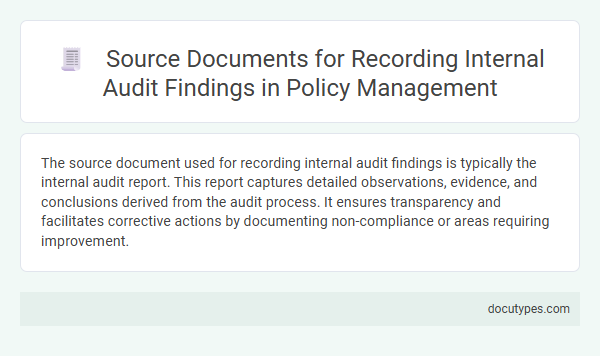The source document used for recording internal audit findings is typically the internal audit report. This report captures detailed observations, evidence, and conclusions derived from the audit process. It ensures transparency and facilitates corrective actions by documenting non-compliance or areas requiring improvement.
Introduction to Source Documents in Policy Management
In policy management, source documents serve as the primary evidence for recording internal audit findings. These documents provide a factual basis that supports the audit conclusions and ensures accuracy.
Common source documents include audit reports, internal memos, compliance checklists, and control activity records. Proper identification and use of these sources enhance transparency and accountability in the audit process.
Importance of Proper Documentation in Internal Audits
Proper documentation of internal audit findings is critical for ensuring transparency, accountability, and effective risk management within an organization. The source document used for recording these findings serves as a foundational record that supports audit conclusions and facilitates follow-up actions.
- Audit Working Papers - These documents capture detailed evidence, observations, and methodologies used during the internal audit process.
- Internal Audit Reports - Summarized findings and recommendations are formally documented in these reports for management review and decision-making.
- Issue Logs or Findings Registers - Ongoing tracking of identified audit issues and corrective actions is maintained in these source documents.
Types of Source Documents for Audit Evidence
Source documents are essential for accurately recording internal audit findings and validating audit evidence. These documents provide the factual basis required to support auditor conclusions and recommendations.
- Invoices and Receipts - These documents confirm transactions and financial activities, serving as proof of payments and purchases.
- Internal Reports - Reports generated within the organization, such as financial statements and compliance checklists, offer detailed insights into operational areas.
- Meeting Minutes and Correspondence - Records of meetings and official communications help demonstrate decision-making processes and policy adherence.
Your ability to reference appropriate source documents ensures the credibility and reliability of internal audit findings.
Key Elements of Effective Audit Documentation
Internal audit findings are typically recorded in the audit working papers, which serve as the primary source document for documenting evidence, observations, and conclusions. Key elements of effective audit documentation include clarity, accuracy, and completeness to ensure the findings are easily understood and verifiable. You must ensure that all audit work is properly supported by relevant documents, reflecting the audit process and results comprehensively.
Standardized Templates for Recording Audit Findings
Standardized templates are the primary source documents used for recording internal audit findings. These templates ensure consistency, clarity, and completeness in documenting observations, risks, and recommendations. Your audit team can enhance efficiency and maintain compliance by utilizing these structured formats.
Ensuring Data Integrity and Authenticity in Source Documents
The source document used for recording internal audit findings is typically the Internal Audit Report, which ensures data integrity and authenticity throughout the audit process. Maintaining a verifiable and original source document protects the accuracy and trustworthiness of your audit results.
- Internal Audit Report - Official document capturing detailed audit findings, evidence, and conclusions.
- Original Evidence Records - Supporting files such as logs, receipts, or system outputs that validate audit observations.
- Audit Working Papers - Organized notes and analyses prepared by auditors to substantiate the reported findings accurately.
Best Practices for Storing and Retrieving Audit Documents
| Source Document for Recording Internal Audit Findings | Internal Audit Working Papers |
|---|---|
| Description | Internal audit working papers serve as the primary source document for capturing audit findings, evidence, and conclusions during the audit process. They include detailed notes, checklists, evidence copies, and auditor observations. |
| Best Practices for Storing Audit Documents |
|
| Best Practices for Retrieving Audit Documents |
|
Compliance Requirements for Audit Documentation
What source document is used for recording internal audit findings in compliance with audit documentation requirements? The working papers serve as the primary source document to capture all internal audit findings accurately. Your audit documentation must comply with regulatory standards to ensure findings are clear, complete, and verifiable.
Common Challenges in Managing Audit Source Documents
Internal audit findings are typically recorded using the Audit Working Papers, which serve as the primary source document. These papers include detailed evidence, observations, and conclusions gathered during the audit process.
Common challenges in managing audit source documents include maintaining accuracy and ensuring proper version control. You must implement robust documentation practices to avoid misplaced or incomplete records that can compromise the audit's reliability.
What Source Document Is Used for Recording Internal Audit Findings? Infographic

